A Philodendron is one of the most common plants out there and it has lots of varieties. The plant exists in any kind of shape and size but most of them tend to grow huge and might take a whole lotta space of your home in time. Most of them require about the same care routine.
Common care tips. Most Philodendrons:
- Tend to root rote if you overwater the plant. The watering routine normally follows drying the soil almost completely. Wait until the plant is 70% dry and then water.
- Tolerate low-light but thrive in medium and bright indirect light.
- Don't need to be fertilizing as often. Normally once in 4-6 weeks during a growing season is enough.
- Love humidity when it's 60% and above.
The Philodendron plant is divided into two main types - climbing and non-climbing or creeper varieties. Those philodendrons that curl need a pillar or other support structure to climb. The crawling Philodendrons do not get as tall as climbing ones yet still are quite spreading and require a lot of free space. On the other hand, you don't need to come up with any support for these kinds of plants. The climbing Philodendrons get really massive so you have to keep in mind, they would need lots of room when big.
Climbing Philodendron varieties include:
- Мelanochrysum
- Splendid
- Verrucosum
- Gigas
- Ventricosum
- Majestic
- El choco red
- Sodiroi
Philodendrons that do not climb up have an erect, widely spreading growth. Non-curly species can be twice their height, so they need to provide enough room for elbows.
Non-curly Philodendrons include:
- Gloriosum
- Glorious
- Mamei
- Pastazanum
- McDowell
- Plowmanii
- Luxurians
Climbing Philodendrons
So, let's start with the first type of philodendron, these are curly varieties that are used to climbing up.
Philodendron Мelanochrysum
- Has long (grows for up to 2 feet in length) leaves
- Is very dark green, almost black
- The backside is green as well
- The veins are bright yellow
Philodendron Melanochrysum or sometimes called the Black Gold is a beautiful tropical plant. The leaves are dark green, almost black, crystalline leaves that stand out with a bright yellow vein, long in shape with a green backside. Yellow veins form a unique pattern.
The leaves grow up to impressive 2 feet in length. The plant itself can get up to 6 feet tall indoors and to impressive 20 feet in height outdoors.
Philodendron Verrucosum
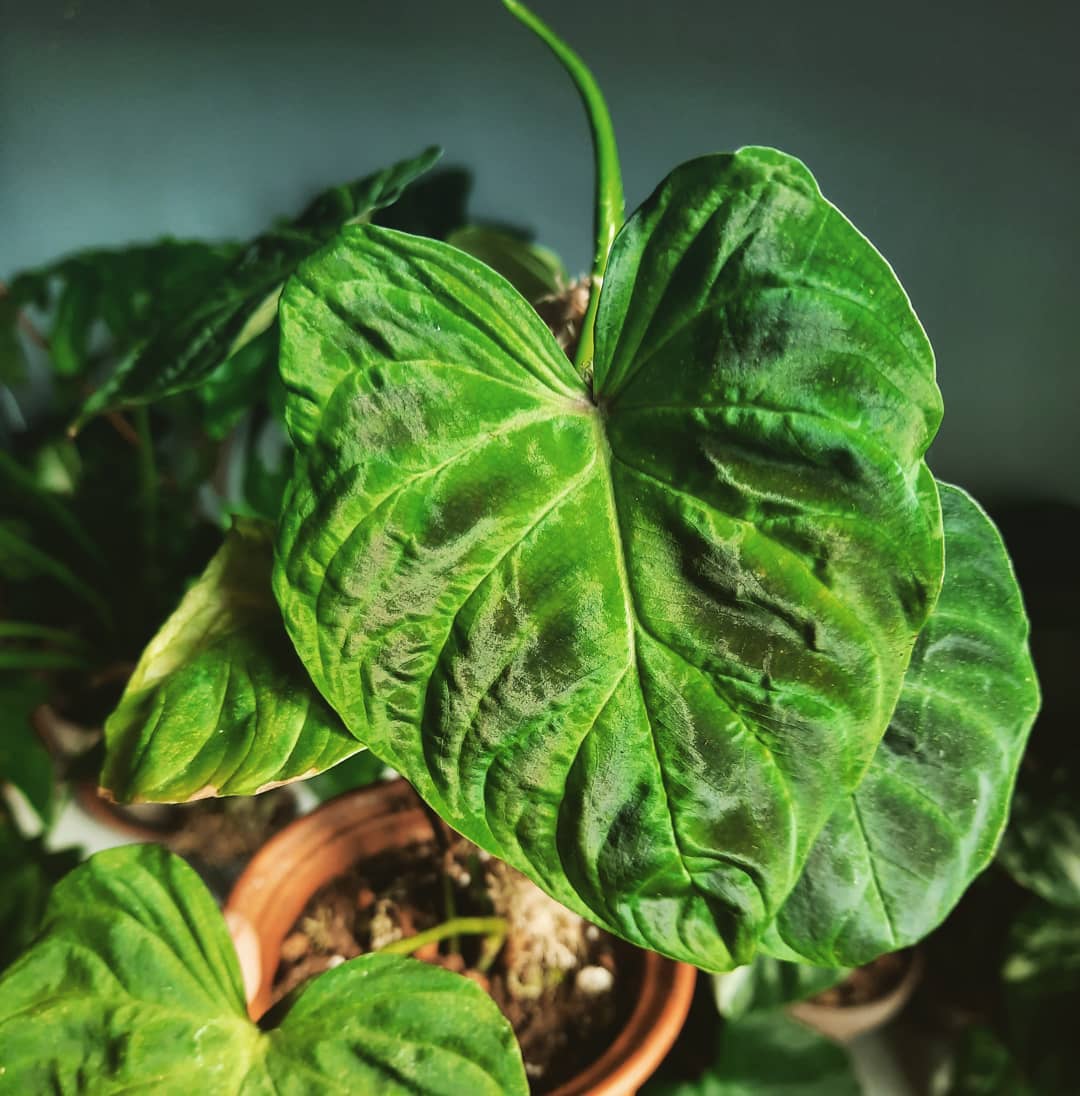
- The leaves are heart-shape
- Has a very beautiful structure with bright veins
- The backside of the leaves is red (some varieties are green tho)
- Some varieties have a hairy petiole
Philodendron Verrucosum is a colorful philodendron with velvety leaves. The leaves are reddish with a red backside. Unlike the Melanochrysum, Verrucosum is roundish with bright veins that form a more structured leaf. Also, some of the Verrucosum have a hairy petiole, unlike other heart-shaped species such as Philodendron Gloriosum or Philodendron Pastazanum.
The plant can get about 6 to 50 inches (150-1500 cm) tall in good conditions. The leaves can get up to 90 cm in height. If the plant is not provided with support for climbing, it will take much longer for the plant to reach maturity, or it may never even reach this stage. It should also be noted that these plants grow better in the winter months.
There are many varieties of Philodendron Verrucosum, but at least two of its forms can be distinguished, and this is the Verrucosum with a red backside of the leaf blade and a Version with a green backside.
Philodendron Splendid or Мelanochrysum x Verrucosum Hybrid
Another spectacular plant for your home that will bring a little jungle into your life is Philodendron Splendid which is a hybrid of the Мelanochrysum and Verrucosum.
- The leaf shape is taken from Melano but does not grow as long.
- The leaves are more structured than Melano but not as much as you can see in the Verrucosum.
- Verrucosum gave Splendid its redness in the backside of the leaves as well as the front side.
- The veins are not as structured as in the Verrucosum but are not bright yellow as in the Melano.
At first, there is no visible difference between a Splendid and Verrucosum or Мelanochrysum especially when the plant is small. But even then, you can see the Melano leaves to be more greenish and the Verrucosum are more roundish. The Splendid leaf is a mix of both. Not as round as the Verrucosum and looks similar to the Melano when the plant is small too. However, not as greenish. It took the redness from the Verrucosum and the shape of the Melano. A beautiful child of the two's love.
The plant itself is capable of growing up to 10 feet in height (3 m). The leaf can get up to 2 feet (60 cm) long. This is a very large plant.
Splendid leaves are very large and even larger than other philodendrons, spear-shaped, and have a velvety texture and glowing veins that will draw your attention from across the room.
Philodendron Gigas
- Velvety green leaves with yellow and brown speckles
- One of the three large Philodendron variety
- Longish shape leaves
This plant is oftentimes compared with Philodendron Melanochrysum because of the huge leaves.
Another popular variety of climbing Philodendrons is the Philodendron Gigas. It definitely stands out for its huge, velvety leaves that have a few shades of green or copper as the plant matures. Large leaves are capable of reaching over 3 feet in length.
The plant itself also attracts attention for its size. A giant like Gigas, when properly kept, can grow up to 8-10 feet (up to 3 m) with 3-4 ft (90-120 cm) long leaves.
Do not forget to provide support for a Philodendron Gigas.
Philodendron Ventricosum
Philodendron Ventricosum is an epiphytic climbing plant. This Philodendron variety is not so popular, but no less beautiful.
Ventricosum is native to the jungle and crawls on the forest floor like a small vine, and when it reaches a tree it begins to climb. Philodendron Ventricosum has a rope-like stem on which there are beautiful deep emerald green leaves with a golden border that grow up to 50-60 cm in length.
This rare and easy-to-grow deciduous plant will add style and tropical greenery to any space.
Philodendron Мajestic
- The leaves are heart-shaped and slightly elongated.
- The adaxial leaf surface has silvery-gray spots.
The Philodendron Majestic is a hybrid of Philodendron Verrucosum and Philodendron Sodiroi Hort. And it contains the best qualities of both representatives of the philodendron.
These traits are seen on their beautiful, heart-shaped leaves, but the leaves are slightly elongated. So on the abaxial surface of the leaf, you can see the features of Verrucosum, and on the adaxial surface of the leaf, you will notice beautiful silvery-gray spots and a slightly bluish surface from Philodendron Sodiroi.
You should also know that this plant is a little more difficult to care for. But if all the conditions are met, Philodendron Majestic will become a sensation among your plants, because it is a rare aroid part of the Arasov family.
Philodendron El Choco Red
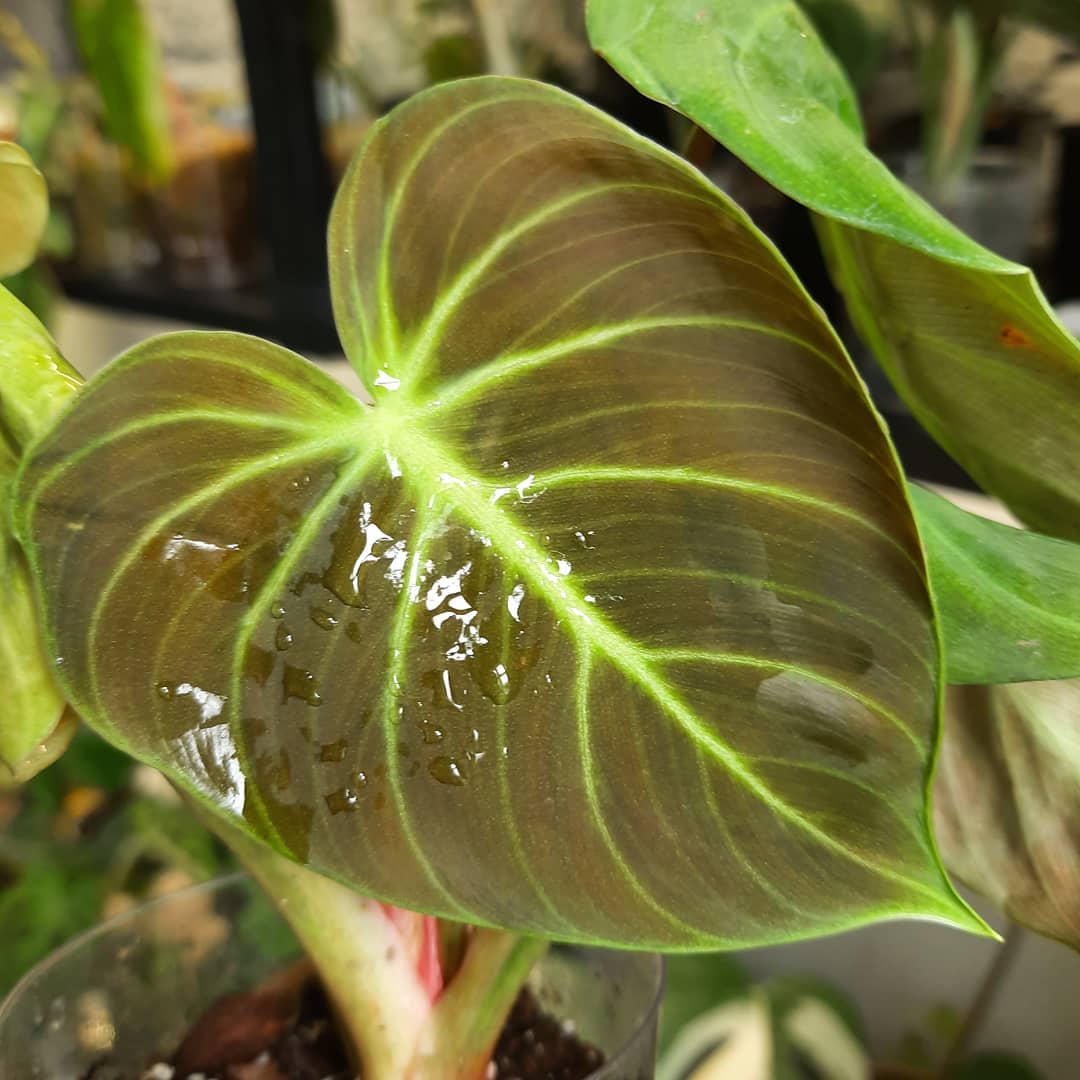
- The leaves are velvety and red on the backside
Philodendron El Choco Red is a colorful representative of the Philodendrons. It is a curly aroid with velvety leaves. Leaves begin with a striking red abaxial leaf surface that fades slightly as it ripens.
Philodendron El Choco Red is quite similar to its relative Verrucosum, we talked about it above. It is an equally striking, fast-growing aroid with multi-colored leaves, and also curly.
Philodendron Sodiroi
- Difficult to find plant
- Heart-shaped leaves
- Silvery spots on the upper side of the leaves
- Shiny leaves
The Philodendron Sodiroi is also called the Silver Leaf Philodendron.
This magnificent plant is adorned with heart-shaped leaves that have silvery spots on the upper side (adaxial side). The leaves themselves are shiny and this silver pattern makes them very unique. The abaxial side of the leaf is light green in Sodiroi. The middle vein on the leaf is bright green, there are lateral veins running parallel to each other. Cataphylls in this species of Folodendron are two-colored, a mixture of green and red best describes this.
Sodiroi does not boast much of its growth rate, it can be characterized as medium and fast-growing under the right conditions. During the growing season, they grow 1-3 feet.
In terms of care, Philodendron Sodiroi does not differ much from other Philodendron plants. And these plants are actually pretty easy to care for.
Creeper Philodendrons
The Philodendrons that do not climb up but only crawl are no less amazing plants.
Philodendron Gloriosum
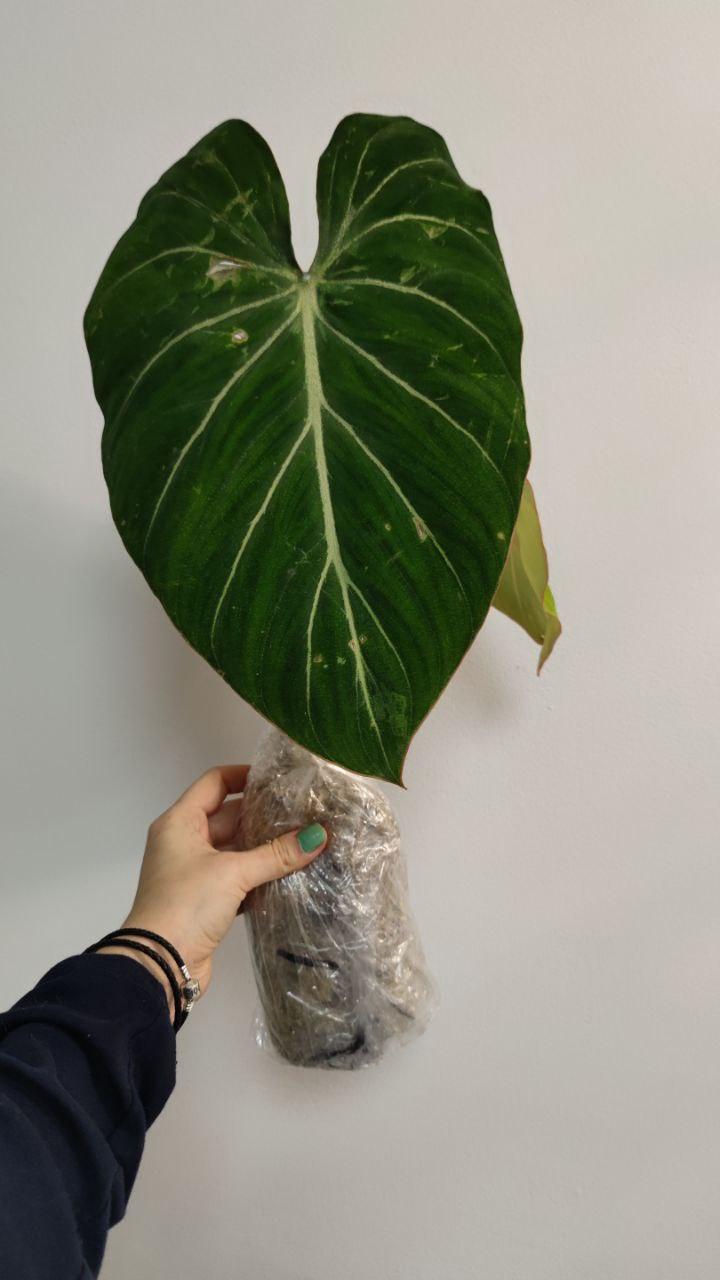
- Heart-shaped velvety leaves.
- Bright white veins make contrast with green leaves.
- A slow-grower
A Philodendron Gloriousum is probably the most popular terrestrial Philodendron. It is a terrestrial plant and is a crawling philodendron. Creeping means that its stem grows horizontally over the surface.
The leaves of this plant cant get up to 26 inches (90 cm) in their natural habitat. The velvet heart-shaped leaves are green with bright white veins to contrast the greenish color.
Philodendron Gloriosum’s growth rate is slow. it may take over a month for one leaf to open.
Philodendron Glorious
- The leaves are velvety and compared to Gloriousum are longer and narrower but not as long as the Melanochrysum
- Has a round petiole
- Due to the Melanochrysum lineage, the leaves are darker
A Philodendron Glorious is a hybrid of Philodendrons Gloriosum and Melanochrisum. It takes the greenish shade and longer shape of the Melanochrysum and narrower compared to P. Gloriosum. The leaves grow to about 50 cm long and 20 cm wide.
Unlike other relatives, the Glorious is unique as it can both climb and crawl depending on the conditions. The young plants look very similar to Gloriosum but the Glorious petiole is round when the Gloriosum has a D-shaped petiole.
Keep in mind, this plant is sensitive to cold, and the leaves will turn yellow from hypothermia.
Philodendron Мamei
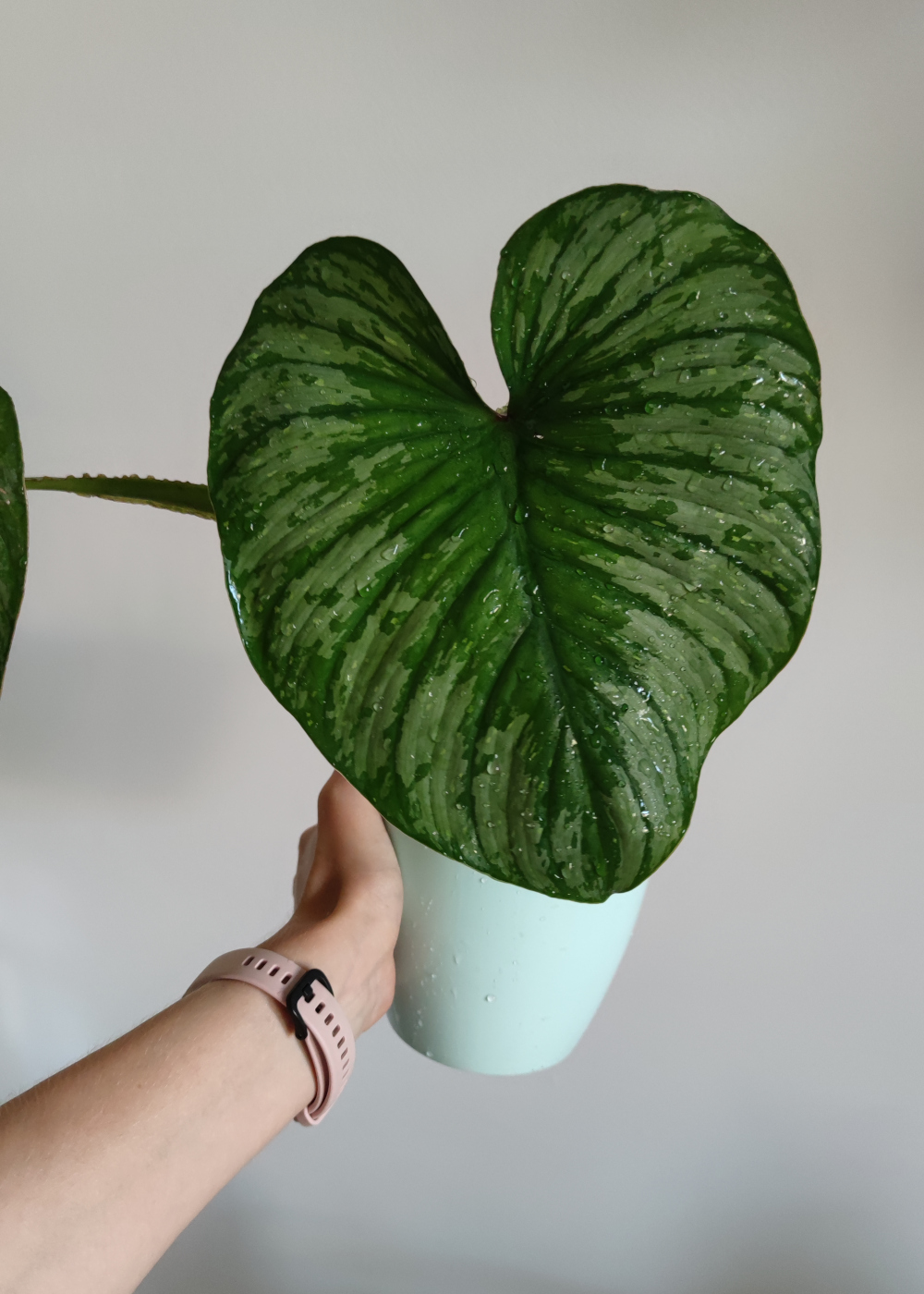
- Heat-shaped leaves
- Has silvery markings that resemble finger marks
- The veins on the leaves run deep
The Philodendron Mamei is a fast-growing Philodendron. Indoor the plant grows to 5-8 feet (150-240 cm) in height with medium heart-shaped leaves. If you want Philodendron Mamei to grow bushy, then prune the tips, this is also a great way to propagate the plant.
You can see silvery markings on the leaves that resemble finger marks and the plant is also called Silver Cloud. It should also be noted that the leaves are less leathery than in other species, and the veins on the leaves run deep, and this gives the leaves a folded appearance.
Philodendron Pastazanum
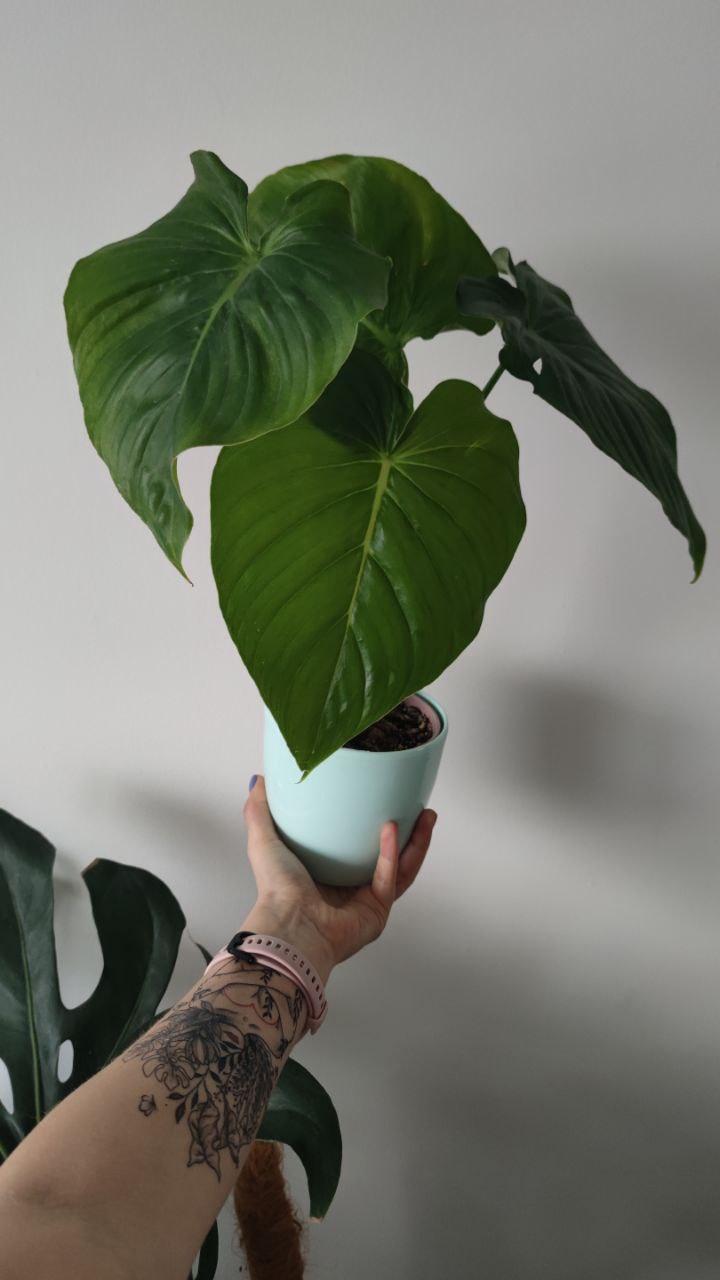
- The semi-glossy texture leaves.
- White veins.
- The leaves are medium to deep green.
- Leaves get to 2 feet (60 cm) in length and diameter.
Meet another very rare and beautiful representative of the creeping, this is Philodendron Pastazanum. The average height of a mature plant is around 3 to 5 feet (90-150 cm). Moreover, it spreads around 4 to 6 feet (120-180 cm) wide. The leaves grow up to 2 feet in length and diameter.
The leaves are heart-shaped semi-glossy medium to deep green with beautiful white veins. The new leaves of this creeping plant are light green in color, and when they grow and become large, they acquire a dark green color.
Pastazanum is not very fast-growing and, at best, the growth rate of this vine is average. Indeed, in order for a new leaf to appear and fully unfold, it takes a month or more.
So, first, you will see the thorn of the leaf, it will expand vertically and grow longer and longer until it closes the new leaf that unfolds.
The rhizome of this Philodendron should not be immersed in water and remain on the soil surface, as this can lead to decay, and it is there that new leaves should appear. And this is a common mistake when caring for Philodendron Pastazanum.
Philodendron McDowell
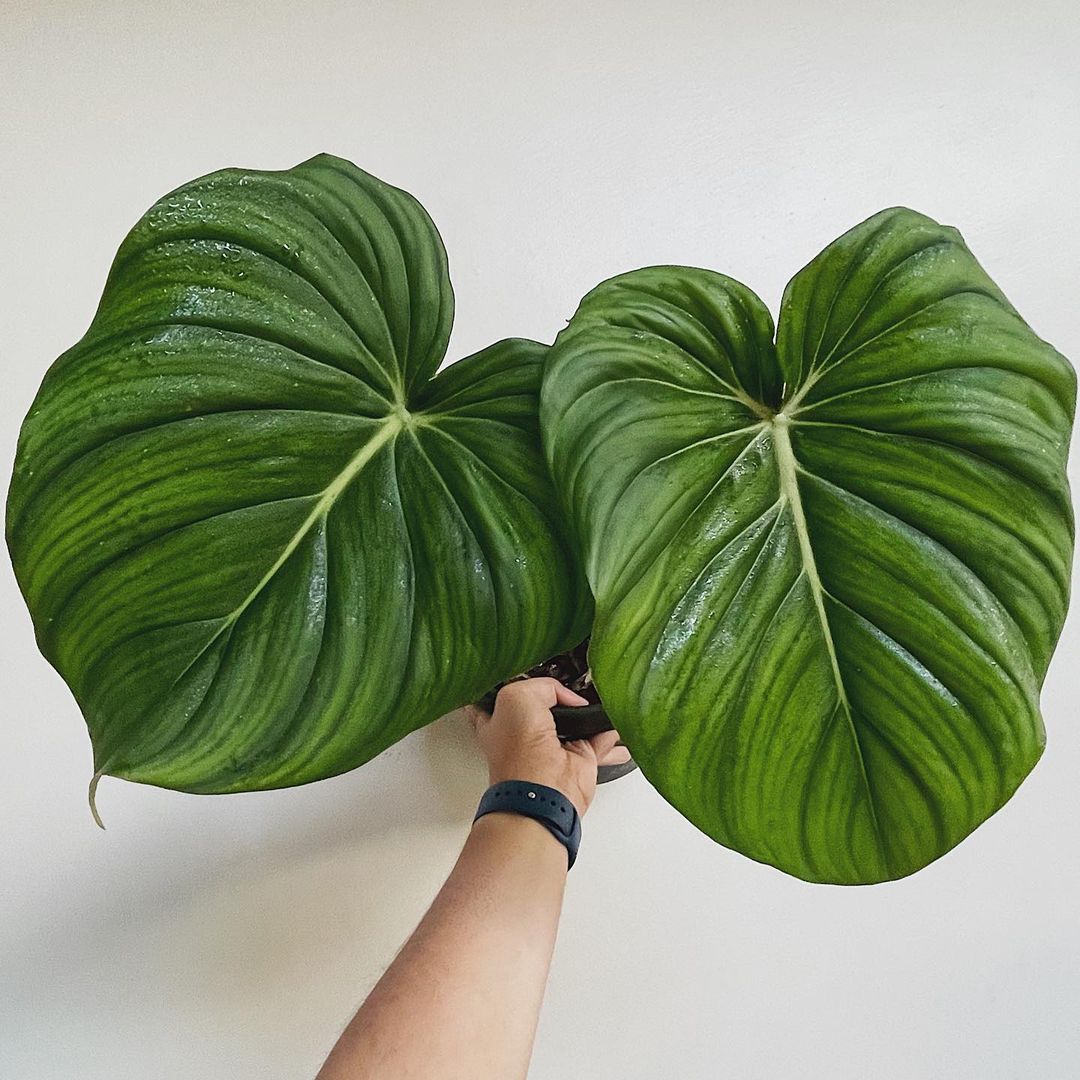
- Large heart-shaped leaves.
- Prominent white vines complement deep forest green leaves.
- Not very tall but can get massive in breadth.
The Philodendron McDowell is a hybrid of Pastazanum and Gloriosum. McDowell has large, heart-shaped, dark green leaves with prominent white veins. What else can be said about the appearance of this variety is that McDowell is classified as a short philodendron because it is a terrestrial variety that prefers to crawl rather than climb. Thus, its mature height is about 2-3 feet (60-90 cm). But in breadth, this plant can grow to its maximum size, about 6.5 feet (2 m).
Philodendron McDowell has a big advantage - it stays at an acceptable height. But it also needs space, as it grows sprawling. In care, it does not differ much from other species and it will not be difficult to grow.
Philodendron Plowmanii
- Huge dense leaves with a gradient.
- Slow-growing specie.
- Creamy yellow color veins.
Philodendron Plowmanii has huge dense leaves with gradient color however, keep in mind that this is the rare philodendron variety that will make you keep looking.
Plowmanii is a slow-growing tropical plant. But regardless of whether it grows on the street or in the house, it needs a lot of space, because it grows up to 8 feet (243 cm) in height. But in order to achieve this size, it is better to grow this species in the open field. Philodendrons are famous for their beautiful leaves, and of course, the main attraction of Plowmanii is its large leaves with many gradients of green that contrast with the creamy yellow color of the veins.
Philodendron Plowmanii is a very decorative and impressive variety, a real find for true collectors. And since the leaves are the main attraction of this plant, you need to stimulate their growth with the right care.
Philodendron Luxurians
- Thick petioles.
- Erect and spreading leaves.
- Ovoid-heart-shaped dark green leaves.
- Matte and velvety above and lighter reddish pink on the backside.
- The veins with projections.
And now the last of the list of crawling Philodendrons are the Philodendron Luxurians. This is a tropical plant that was recently discovered and described. So Luxurians have thick petioles, erect and spreading leaves, but the leaves need more attention.
The leaf plates of such a Philodendron are ovoid-heart-shaped, dark green in color, matte and velvety above and noticeably lighter and slightly reddish-pink on the abaxial side, and there are veins with projections.
The Luxurians philodendron is a little difficult to grow at home and is susceptible to mite infestations if the humidity level is not maintained. And it requires very high relative humidity to grow.
Philodendrons with oblong leaves
Oh, we almost forgot, because there is also a group of Philodendrons with elongated leaves. And you know what, such Philodendrons outwardly do not look at all like those that we considered above (crawling and climbing), it's all about long leaves. But rest assured, they will be able to win your heart and fall in love with themselves.
And here are the representatives of the species with oblong leaves:
- patriciae
- esmeraldense
- heterocraspedon
- spiritus sancti
Philodendron Patriciae
- Rippled leaves and lush shades.
- Long, pleated leaves.
- Climbing plant.
- Epiphyte, survives in little water and fertilization conditions.
Bring variety to your indoor garden with Philodendron Patriciae and its gorgeous, richly colored leaves.
This tropical plant is an epiphyte and has grooved leaves and varied shades that make the plant adaptable to different habitats because it requires little water and little fertilization. Its leaves fall from the stems like curtains. Grow to the point of about 48 inches long by 11 inches wide.
The Philodendron Patriciae is easy to care for, but it needs humid air to grow well, with a moisture content of at least 75%. Moderate watering, high humidity, and occasional fertilization will give your plant the care it needs.
Philodendron Esmeraldense
- Longish leaves with a velvety sheen.
- Epiphytic.
- Large glossy dark green leaves.
- Leaves have a leathery feel and heavy veining.
Philodendron Esmeraldense is a broadleaf philodendron famous for its foliage. However, it is a rare aroid with very few requirements, namely indirect light and high levels of humidity, but the plant also does not tolerate cold temperatures.
Philodendron Esmeraldense is an epiphytic plant and has large, dark green glossy arrow-shaped leaves with a velvety sheen. The underside of the leaf is lavender and the top is green with slight wrinkles. The average size of a mature leaf can be at least 19 in long and 3 in wide. The dense leaves have clearly visible veins.
Esmeraldse is also a climbing species and grows by climbing up and needs a support. It grows quickly and can grow to a height of 6 to 8 feet.
Philodendron Heterocraspedon
- Climbing plant.
- Long, pleated leaves.
- Petioles are deeply sulcate.
- Velvety and semigloss adaxial.
When you come across Philodendron Heterocraspedon, you will immediately understand that it is Heterocraspedon. It has a unique growth habit, most of the leaves are generally clustered near the top of the stem, and the long leaves hang down.
This philodendron is mostly hemiepiphyte, but sometimes it is also terrestrial. Its petioles are C-shaped with a deep groove, one edge of which is very sharp, and the other sharply rounded, the stem is adpressed-curly.
Like all Philodendrons, the leaves are their main decoration. And the leaf blades of Heterocraspedon are oblong-elliptical, moderately bicolor, pointed at the apex, and slightly cordate at the base. The adaxial surface of the leaf is semigloss, velvety, dark green in color, and the abaxial surface is also semigloss, but significantly paler than the adaxial side. There are also noticeable veins on the leaves, the median vein is convex and lighter along the axis, and the lateral veins on each side are long and reach the edge of the leaf.
Philodendron Spiritus Sancti
- very long pendent leaves triangular shape.
- dark green dull-colored leaves.
This species is more expensive and more difficult to obtain and rarer than Monstera Obliqua and Monstera Adansonii.
This tropical philodendron plant is hemiepiphyte and quite large with hanging leaves up to 29 inches in size. Its nature of growth is the same as that of Splendid and Verrucosum, roots sink into the ground and seeds germinate in the crown of the tree.
Since Spiritus Sancti belongs to those Philodendrons that have oblong leaves, they grow up to 22 to 29 inches long and 4.5 to 4.9 inches wide. The leaf blades are dull, dark green in color and predominantly thin. The leaf has four lateral veins of an elongated triangular shape. This Philodendron also has a funny leaf shape and looks like its leaves have rabbit ears.
It should also be added that Philodendron Spiritus Sancti is a climber and climbs up. Therefore, attach it to the moss pole and then the leaves will hang down beautifully.
MichaelNoura #
Oct. 2, 2025, 3 a.m.